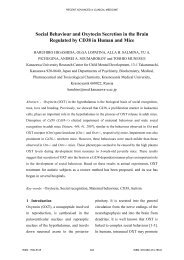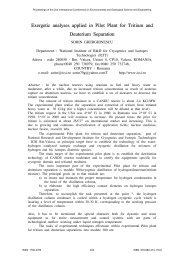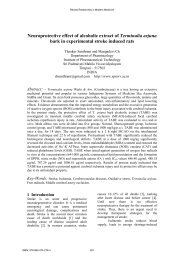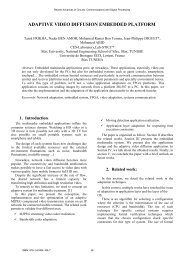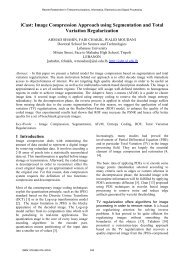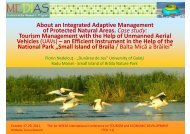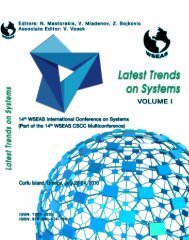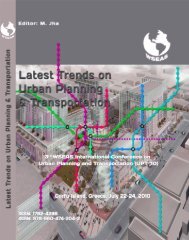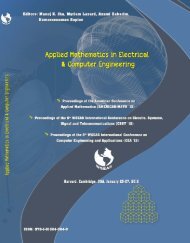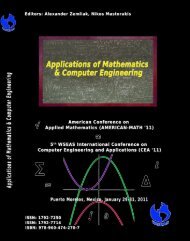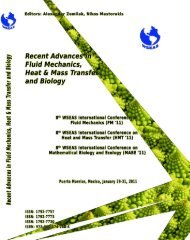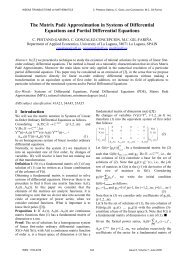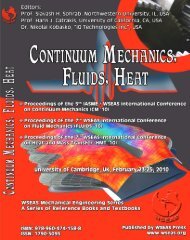ADVANCED MANUFACTURING ENGINEERING ... - Wseas.us
ADVANCED MANUFACTURING ENGINEERING ... - Wseas.us
ADVANCED MANUFACTURING ENGINEERING ... - Wseas.us
Create successful ePaper yourself
Turn your PDF publications into a flip-book with our unique Google optimized e-Paper software.
Proceedings of the 2nd International Conference on Manufacturing Engineering, Quality and Production Systems<br />
Plenary Lecture 2<br />
The Brake Water under Current Action. A Distortional Simulation Approach<br />
Professor Dumitru Dinu<br />
Marine Engineering Department<br />
Constantza Maritime University<br />
104 Mircea Street, 900663 Constantza, Romania<br />
E-mail: dinud@imc.ro<br />
Abstract: In many cases, it is very difficult to represent the phenomena in one scale. For long conduit (pipe-lines, gas<br />
transport tubes, long brake water) we <strong>us</strong>e a great scale for length. If we <strong>us</strong>e the same scale for diameter or breadth, it<br />
results a very thin line. That’s why it is necessary to <strong>us</strong>e a different scale for diameter or breadth in our case, a small<br />
one. By applying the similitude criterions, we obtain other scales for physical magnitudes. Are there near the real<br />
values? What are the differences between the two approaches: one scale and two scales?<br />
In the paper we propose to <strong>us</strong>e the FLUENT program to make a comparison between the results of application<br />
normal similitude and distortional similitude in the experiments regarding current action on the brake water. First, we<br />
established the model law, taking into account the physical magnitudes which influence the analyzed phenomena.<br />
After, we calculated the scales of these physical magnitudes for normal similitude (one geometrical scale) and<br />
distortional similitude (two geometrical scales). Using FLUENT we determined the values of the forces acting on the<br />
brake water, putting the pressure parameters and the dimensions of the conduit according to the two cases of<br />
similitude. Finally, we compare the "experimental" results with theoretical results, calculated by application of scale of<br />
physical magnitudes.<br />
Brief Biography of the Speaker:<br />
Professor Dumitru DINU was born in Constantza in 1948. He graduated University of Galatzi and obtained the degree<br />
of Diplomat Engineer, Naval Architect. He is doctor in Fluid Mechanics.<br />
Courses in France on Marine Technology, Deep Diving Systems; Courses in Romania on Marine Pollution, Marine<br />
Engineering; IMO Courses, etc;<br />
Recognition as Supervisor of doctoral theses since 2001.<br />
He worked as researcher in Romanian Marine Research Institute (1972-1986) and Chief of Marine Technology<br />
Laboratories (1986 – 1990).<br />
Between 1993 and 2004 Professor Dinu was Rector of Constantza Maritime University.<br />
Key qualifications: Fluid Mechanics, Marine Technologies, Marine Pollution, Maritime Education and Training.<br />
International Position: Member CIESM (Conseil International pour Exploitation Scientifique de la Mer Mediteranee),<br />
Member of IMLA Committee (International Maritime Lecturers Association), Romania and IMLA representative at IMO<br />
Assembly, Chairman in vario<strong>us</strong> conferences on MET (Maritime Education and Training).<br />
Scientific activities: 9 books on underwater technologies, hydrodynamics, marine pollution; over 50 papers published<br />
on marine technologies, marine pollution, maritime education and training; certificates for inventions and innovations;<br />
research contract leader.<br />
ISSN: 1792-4693 14 ISBN: 978-960-474-220-2




